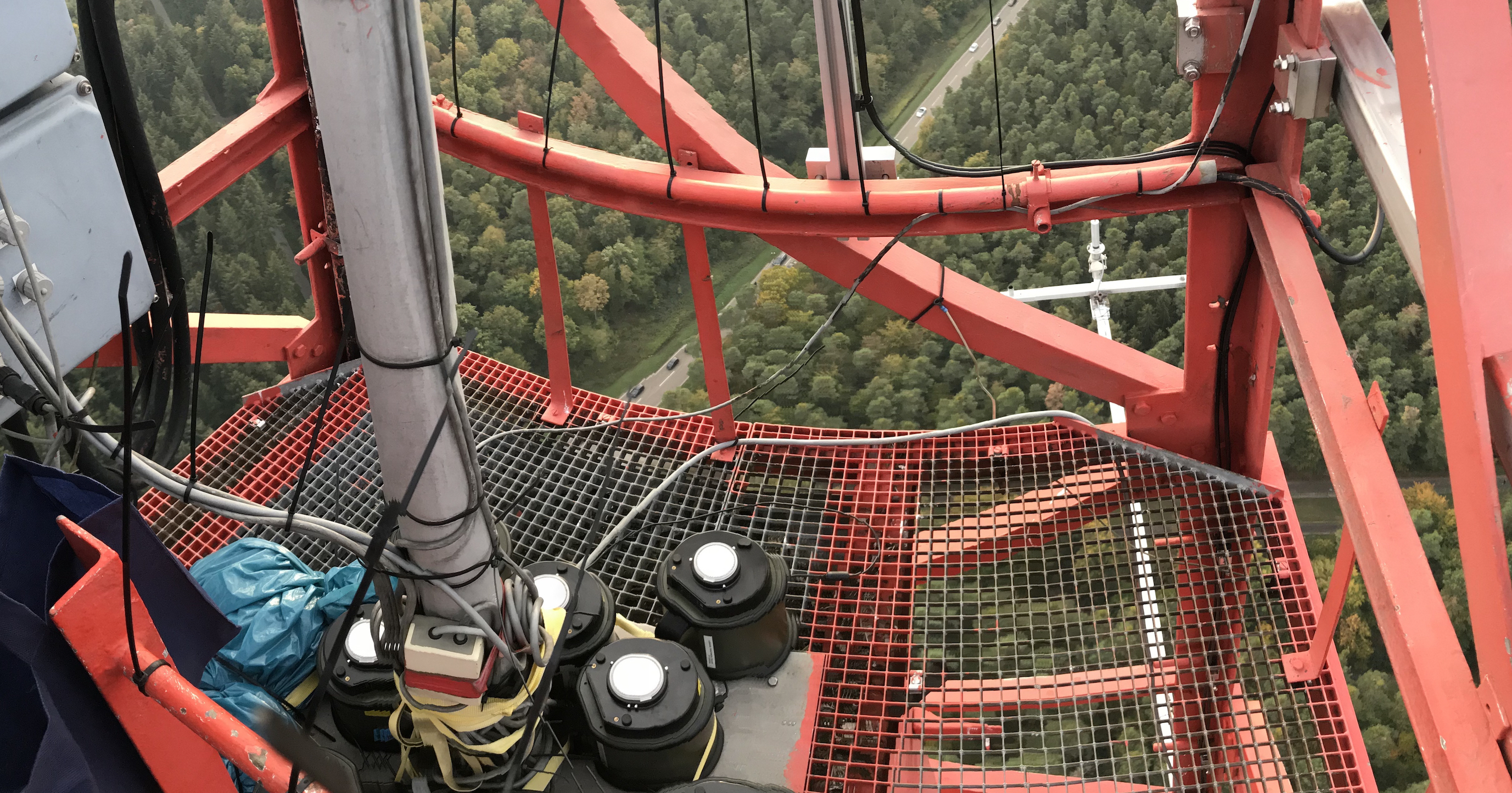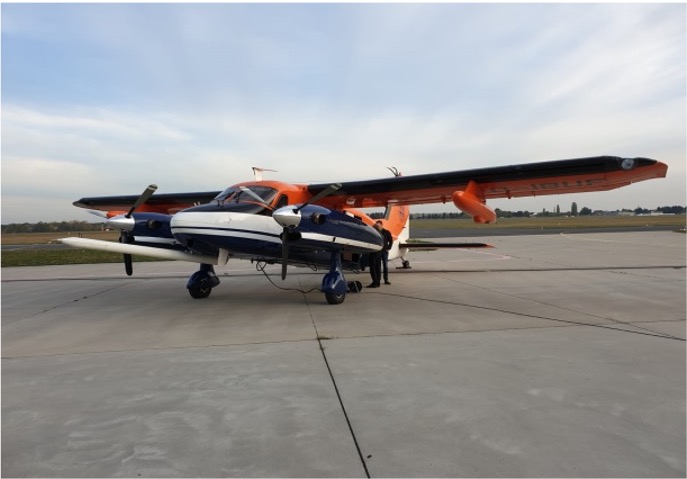Vertical stratification of the air microbiome in the lower troposphere
Publication
 (SASS® 3100 air samplers on sampling time delay at the 200m platform of the KIT meteorological tower in Karlsruhe, Germany)
(SASS® 3100 air samplers on sampling time delay at the 200m platform of the KIT meteorological tower in Karlsruhe, Germany)
Exploring the vertical air microbiome – first attempts
 (Meterological Tower, Karlsruhe Institute of Technology (KIT) )
(Meterological Tower, Karlsruhe Institute of Technology (KIT) )
 (Research Aircraft - Dornier Do-128, Braunschweig, Germany)
Intrigued by our earlier findings that the airborne microorganisms in the tropics follow a precise diel cycle, we wanted to investigate the dynamics and variability of airborne microbial communities associated with different layers of the vertical air column.
One impact of our previous diel cycle experiments was as the establishment of the refinement of sequencing low biomass. This laid the groundwork for designing experiments exploring the vertical boundaries and organization of the air microbiome.
(Research Aircraft - Dornier Do-128, Braunschweig, Germany)
Intrigued by our earlier findings that the airborne microorganisms in the tropics follow a precise diel cycle, we wanted to investigate the dynamics and variability of airborne microbial communities associated with different layers of the vertical air column.
One impact of our previous diel cycle experiments was as the establishment of the refinement of sequencing low biomass. This laid the groundwork for designing experiments exploring the vertical boundaries and organization of the air microbiome.
Our first vertical air sampling experiments were carried out at various levels of a 49-storey residential urban high-rise building (156m a.s.l) in Singapore as well as at the base (1,360m a.s.l) and summit (2,502m a.s.l) of an Alpine mountain in Switzerland. The results initially confounded us as we witnessed very little change in the air microbiome composition at these varying elevations. However, we came to understand that solid objects, such as a large building or a mountain, alter the natural airflow, which results in the mixing of air layers from different altitudes and allows for airborne microorganism from lower altitudes to reach higher air layers. It was clear that we had to find a new - more “groundless” - sampling regime to truly capture the air microbiome composition of different air layers in the vertical air column.
Escaping the boundary layer
In collaboration with meteorologists at the Karlsruhe Institute of Technology and flight engineers at the Technische Universität Braunschweig in Germany, we finally found an ideal solution in a novel vertical testing array comprising a meteorological tower and a research aircraft. This set-up allowed us to conduct synchronized measurements, unaffected by ground effects, of meteorological parameters and airborne biomass (n = 480) in the vertical air column up to 3,500m with high temporal and spatial resolution. A deeper understanding of the interplay between temperature and the dynamics of the local boundary layer made the exploration of the vertical stratification at cooler temperate climates a practical alternative.The diel cycle of airborne microorganisms is a ground-based phenomenon
 ( Diel cycle of airborne microbial communities at different altitudes. Principal coordinate analysis (Bray-Curtis dissimilarity, species level) between research aircraft air samples collected at different time of day and altitudes
)
The taxonomic analysis of the metagenomic data of the collected air samples revealed differing patterns of airborne microbial community composition with respect to time of day and height above ground. Because of the high temporal and spatial resolution of our study, we could demonstrate that the previously described diel cycle of airborne microorganisms is a ground-based phenomenon that is entirely absent at heights >1,000m. This finding led to the discovery that temperature, not sunlight or humidity, is the single most important parameter that influences the composition of airborne microbial communities.
( Diel cycle of airborne microbial communities at different altitudes. Principal coordinate analysis (Bray-Curtis dissimilarity, species level) between research aircraft air samples collected at different time of day and altitudes
)
The taxonomic analysis of the metagenomic data of the collected air samples revealed differing patterns of airborne microbial community composition with respect to time of day and height above ground. Because of the high temporal and spatial resolution of our study, we could demonstrate that the previously described diel cycle of airborne microorganisms is a ground-based phenomenon that is entirely absent at heights >1,000m. This finding led to the discovery that temperature, not sunlight or humidity, is the single most important parameter that influences the composition of airborne microbial communities.
The sky's the sink
 (Dr. Ulrich Corsmeier (meteorologist, Karlsruhe Institute of Technology), holding a SASS® 3100 air sampler, and Rudolf Hankers (pilot, Technische Universität Braunschweig) stand inside the hanger of the Dornier Do-128 research aircraft that was used for this study)
(Dr. Ulrich Corsmeier (meteorologist, Karlsruhe Institute of Technology), holding a SASS® 3100 air sampler, and Rudolf Hankers (pilot, Technische Universität Braunschweig) stand inside the hanger of the Dornier Do-128 research aircraft that was used for this study)
 (Research Associate Carmon Kee prepares SASS® 3100 high-volume air samplers on board the Dornier Do-128, Braunschweig, Germany)
The atmosphere above the mixing layer height on the other hand is proposed to act as a sink for microorganisms. Through a combined analysis of meteorological and biological data, we could show for the first time that atmospheric turbulence and stratification are the defining factors for the scale and boundaries, dynamics, and natural variability of airborne biomass, resulting in the biological organization of the planetary air ecosystem. In addition, we could demonstrate that at least 50% of identified airborne microbial taxa (n = ~10,000) are associated with either ground or height. This finding allows for a better understanding of the dispersal patterns of microbial taxa in the vertical air column.
(Research Associate Carmon Kee prepares SASS® 3100 high-volume air samplers on board the Dornier Do-128, Braunschweig, Germany)
The atmosphere above the mixing layer height on the other hand is proposed to act as a sink for microorganisms. Through a combined analysis of meteorological and biological data, we could show for the first time that atmospheric turbulence and stratification are the defining factors for the scale and boundaries, dynamics, and natural variability of airborne biomass, resulting in the biological organization of the planetary air ecosystem. In addition, we could demonstrate that at least 50% of identified airborne microbial taxa (n = ~10,000) are associated with either ground or height. This finding allows for a better understanding of the dispersal patterns of microbial taxa in the vertical air column.
We also noticed that higher air layers contained an up-to-20-times higher concentration of radio-tolerant bacteria, which are known to withstand ionizing radiation, desiccation, UV radiation, or oxidizing agents. We hypothesise that the ionising rays from the sun and space have contributed to the development of radioactive tolerance in these bacteria at greater height, whereas bacteria closer to the ground are not exposed to such levels of radiation.
Global warming - rising global temperature impacts the planet’s atmospheric air ecosystem
As atmospheric turbulence and temperature are interconnected, the dynamics of microbial dispersal are likely to be impacted by rising global temperatures resulting in major disruptions of the currently observed airborne microbial community structures. We also predict that temperature-driven changes in the air microbiome may affect agricultural crops, thus affecting our food security.
In partnership with:


- Rudolf Hankers (Technische Universitat Braunschweig)
- Dr. Thomas Feuerle (Technische Universitat Braunschweig)
- Dr. Ulrich Corsmeier (Karlsruhe Institute of Technology)
- Stefan Kraut (Karlsruhe Institute of Technology) for supporting the experimental setup on the meteorological tower
- Mark Bitter and Helmut Schulz (Technische Universität Braunschweig) for engineering and implementing changes to the DO 128 aircraft to accommodate our experiments
- The Institute of Meteorology and Climate Research (KIT) for manufacturing scaffolds to mount our air samplers inside the aircraft